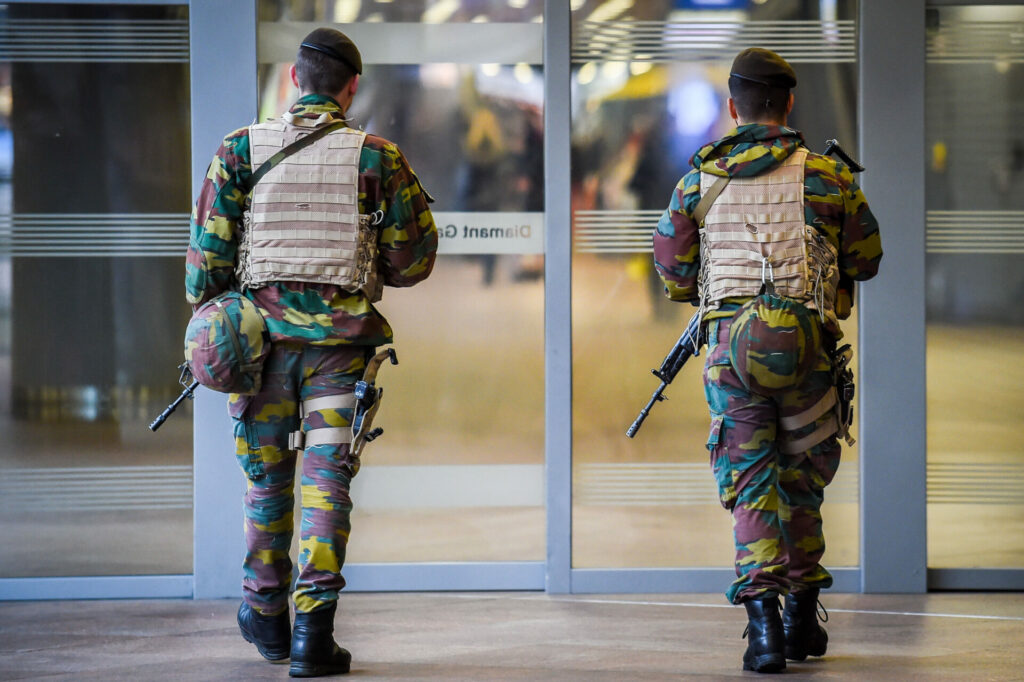The Brussels Court of Assizes, which is currently presiding over the trial of suspects involved in the Brussels terror attacks at the Maelbeek metro station and Zaventem Airport, listened to the testimony of an expert who was able to trace the equipment used by the IS militants in their 2016 attack.
The investigators revealed the detailed instructions that the terror suspects had received for the use of the powerful explosive TATP, of which traces were found in an apartment raided by police on Rue Max Roos in Schaerbeek. The court also began to present its first observations made at one of the terrorists’ hideouts on Rue du Dries in Forest, the Belga News Agency reports.
On Monday morning, the defence announced a new hearing into incidents that transpired during the transfer of the defendants from detention. Lawyer Vincent Luruqin denounced “copy-pasted errors” in the justifications used during the strip searches endured by his client, Hervé Bayingana Muhirwa, stating that the motivation for the searches was not relevant to the conditions on the day.
Lawyer Delphine Paci, representing terror suspect Salah Abdeslam, stated that “the hearing of the policeman who hit Mr. Abdeslam on Wednesday did not present any evidence that would explain how my client was injured in the face.” The Franco-Belgian suspect said that he was beaten by police during a strip search last Wednesday.
After these interjections, the hearing continued with a presentation by Mohamed Fahmi, a theologist working with to the Federal Police. The witness showed how the Islamic State terror organisation had claimed responsibility for the attacks as early 22 March, through propaganda articles, and videos produced in several languages.
According to Fahmi, the videos exaggerated the facts behind the attacks, mixing lies and praising the attacks to attempt to sway the public towards the ideology of IS. The objective of the attack, the expert claimed, was also to send the following message: “Stop your war against us, or we will continue to carry out attacks.”
Explosives
In the afternoon, an expert from the Belgian Army’s Explosive Ordnance Disposal and Destruction (Service Sedee) detailed how instructions for the use of the explosives employed by the attackers were found at the apartment in Schaerbeek.
The expert notably revealed that the first bomb detonated at Zaventem airport was not placed on a luggage cart when it exploded, as previously believed. In had instead been placed on the ground by suicide bomber Ibrahim El Bakraoui.
While some explosives require specialist knowledge to fabricate, the bomb expert says that the production process of TATP was not considered complex, stating that “a child can do it by following the instructions to a letter.” Despite this, the substance used was extremely volatile, and required great caution to handle.
The army expert also confirmed that the bomb left by Mohamed Abrini could have exploded at the smallest knock by emergency services. Abrini fled without detonating his payload at Zaventem Airport.
According to estimates presented by the expert, during the Zaventem attack, the perpetrators were carrying three 30 litre sports bags, loaded with approximately 90 kilograms of explosives in total. In Maelbeek, two 15 litre backpacks, filled with 30 kg of explosives were used.
In total, the terrorists used 120 kg of explosives in their senseless murder of 32 people. An additional 6 kg of explosive materials were recovered from the Max Roos apartment. Experts believe that it took the jihadists 10 days to fabricate the bombs.
'Pivotal date'
At the end of the afternoon, investigators returned to the topic of the shooting that took place on Rue du Dries in Forest, on 15 March 2016, which occurred between Belgian special and forces and Mohamed Belkaïd, who died to protect the escape of the two living suspects Salah Abdeslam and Sofien Ayari.
Related News
- Brussels attacks trial: Abdeslam to stay in cell until verdict after 'punch in the face'
- Salah Abdeslam files complaint against officer who 'punched' him
Abdeslam and Ayari were already sentenced to 20 years in prison on 23 April 2018 for this incident. For investigators, the shooting incident was a “pivotal date” in understanding the events of 22 March 2016, examining magistrate Berta Bernardo Mendez explained. Jurors looked back into the case to understand the circumstances behind the Abdeslam and Ayari’s arrest four days later.
At the end of the day, an inspector from the criminal section of the Brussels Judicial Police presented the scientific and technical methods employed by the investigators following the shooting. The investigator identified places where DNA traces and fingerprints of the two suspects, who had hidden in Belkaïd, had been discovered.
Furthermore, fingerprints and DNA from several suspects in the Paris Terror Attacks were found on various objects, such as books. The trail is scheduled to resume today.

